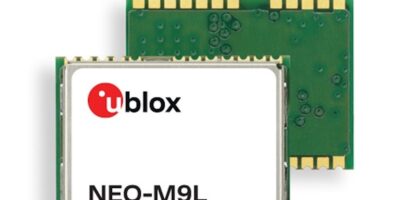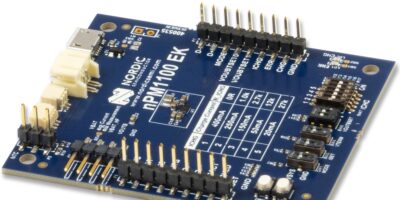Automotive-grade positioning modules that operate up to 105 degrees C has been released by u-blox. The NEO-M9L modules and the M9140-KA-DR chip are built on the u-blox M9 GNSS platform and use dead reckoning techniques to provide position data when satellite signals are compromised or unavailable, says the Swiss company.
The u-blox NEO-M9L-20A and NEO-M9L-01A modules are automotive-grade, with the NEO-M9L-01A variant offering an extended operational temperature range up to 105 degrees C, making it suitable for integration on the roof, behind the windscreen, or inside electronics control units (ECUs).
The modules include six-axis inertial measurement units (IMUs) which deliver low-latency 100Hz raw data output. The modules offer a low latency 50Hz position update rate, for use in real-time applications. The automotive dead reckoning (ADR) output combines the GNSS fix with IMU data to deliver accurate positioning output. Additional GNSS-only output enables seamless integration into a variety of third-party applications. The receiver also supports wake-on-motion, which enables smart features such as theft protection and power-efficient designs.
The modules offer innovative sensor-based spoofing detection for advanced security and robustness. The chip offers protection against possible GNSS signal spoofing, which can cause navigation systems to report faulty position data or time.
“Paired with low-latency position output, attitude, and sensor data, the u-blox NEO-M9L is ready to meet current and future challenges facing the automotive market,” said Aravinthan Athmanathan, product manager, product centre positioning at u-blox.
Target applications for the NEO-M9L-20A and NEO-M9L-01A modules include integrated navigation systems such as in-vehicle infotainment (IVI) and head units, integrated telematics control units (TCU), and V2X.
All the module variants comply with AEC-Q104.
Engineering samples and evaluation kits will be available by the end of September 2021.
u‑blox specialises in positioning and wireless communication in automotive, industrial, and consumer markets. Its products and services let people, vehicles, and machines determine their precise position and communicate wirelessly over cellular and short range networks. The portfolio includes chips, modules, and secure data services and connectivity, to empower its customers to develop solutions for the IoT. u-blox’s headquarters are in Thalwil, Switzerland with offices in Europe, Asia, and the USA.







